Creating stunning front yard landscaping with rocks and mulch offers homeowners an exceptional combination of natural beauty, sustainability, and low maintenance appeal. These versatile materials work harmoniously to provide texture, color variation, and practical benefits including improved drainage, weed suppression, and moisture retention. Whether you prefer desert-inspired xeriscaping, tranquil zen aesthetics, or contemporary modern designs, rocks and mulch can transform any front yard into an inviting outdoor space. From small urban courtyards to expansive suburban properties, these landscaping elements adapt beautifully to diverse architectural styles and regional climates while reducing water consumption and ongoing maintenance requirements.

1. Desert Oasis Xeriscaping with Decomposed Granite
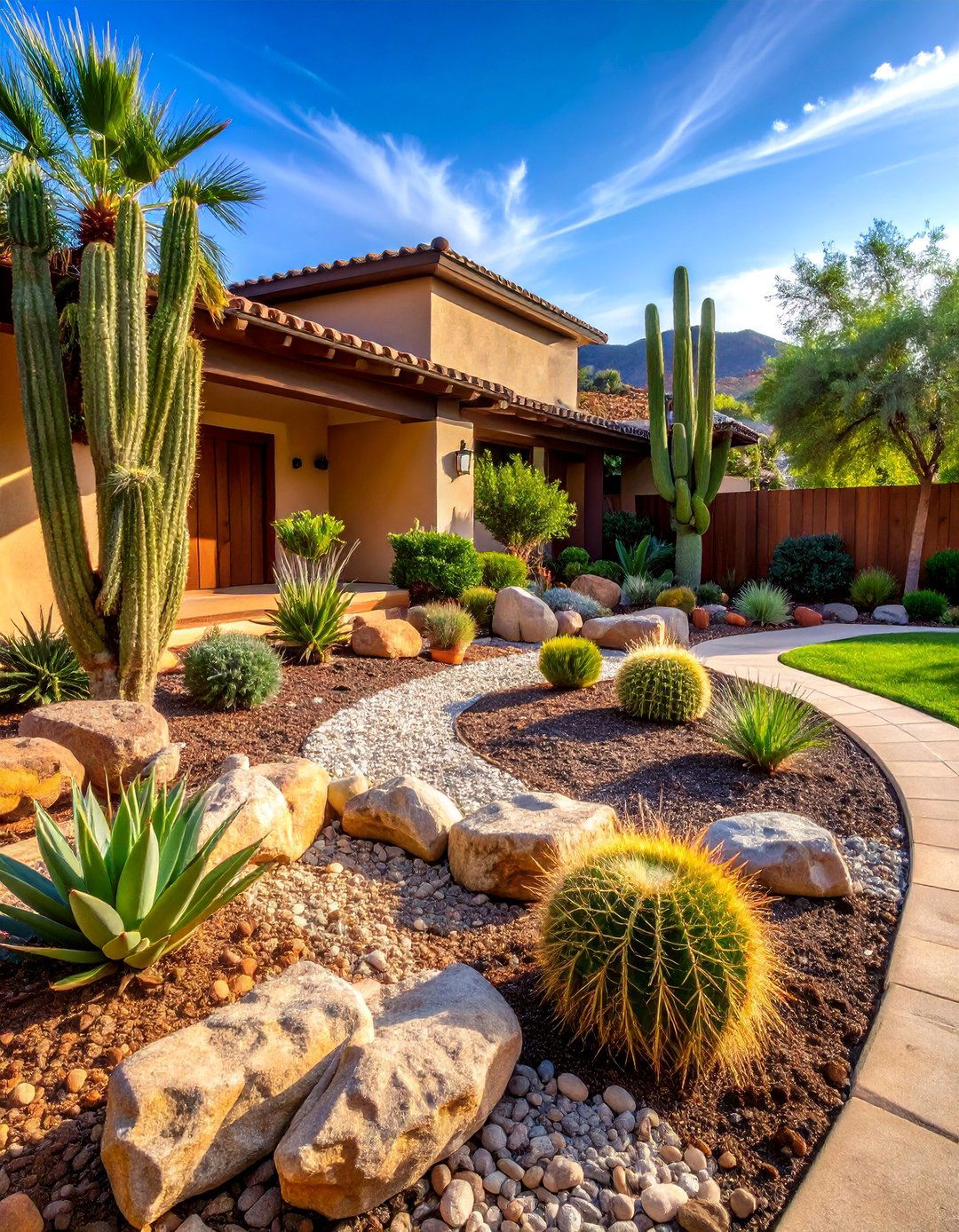
Transform your front yard into a stunning drought-tolerant landscape using warm-toned decomposed granite as the primary ground cover, accented with strategically placed boulders and desert plants. This design features clusters of barrel cacti, agave, and prickly pear positioned among weathered sandstone rocks of varying sizes. Dark cocoa mulch surrounds individual plant groupings to provide moisture retention and visual contrast against the light granite base. Ornamental grasses like fountain grass add movement and soften harsh edges, while a meandering pathway of flat flagstone leads visitors through this water-wise paradise that thrives in arid climates.
2. Japanese Zen Garden with Raked Gravel Patterns
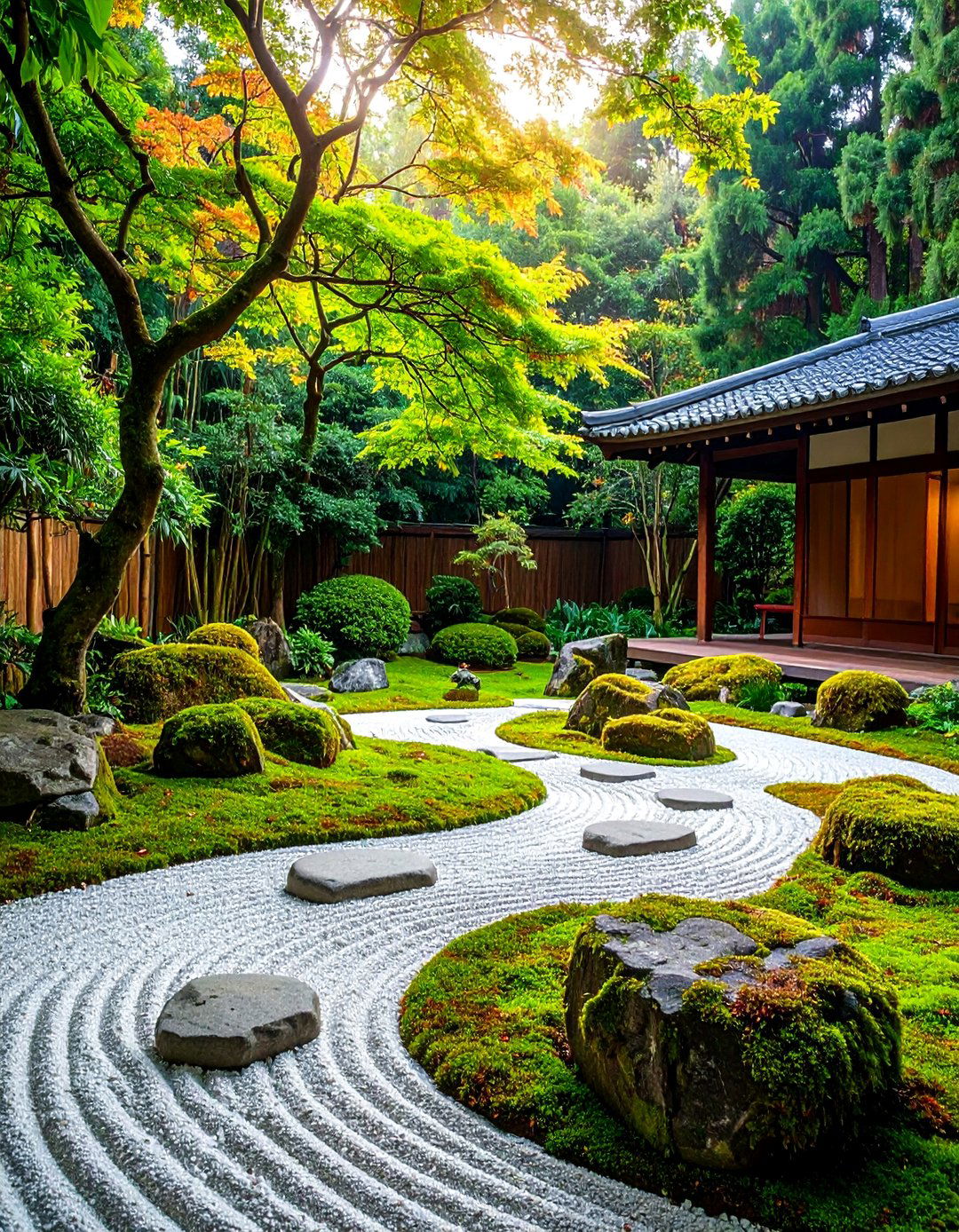
Create a serene meditation space using fine white gravel as the foundation, meticulously raked into flowing patterns that represent water ripples around carefully positioned moss-covered boulders. This minimalist design incorporates a single Japanese maple as a focal point, surrounded by low-growing moss and small ornamental stones. Bamboo screening provides privacy and authenticity, while a simple wooden bench offers contemplation space. The contrast between smooth river rocks and textured bark mulch defines distinct zones within the garden. Strategic lighting illuminates key elements for evening enjoyment, making this tranquil retreat perfect for mindfulness practices and stress relief.
3. Modern Geometric Rock Garden with Colorful Mulch
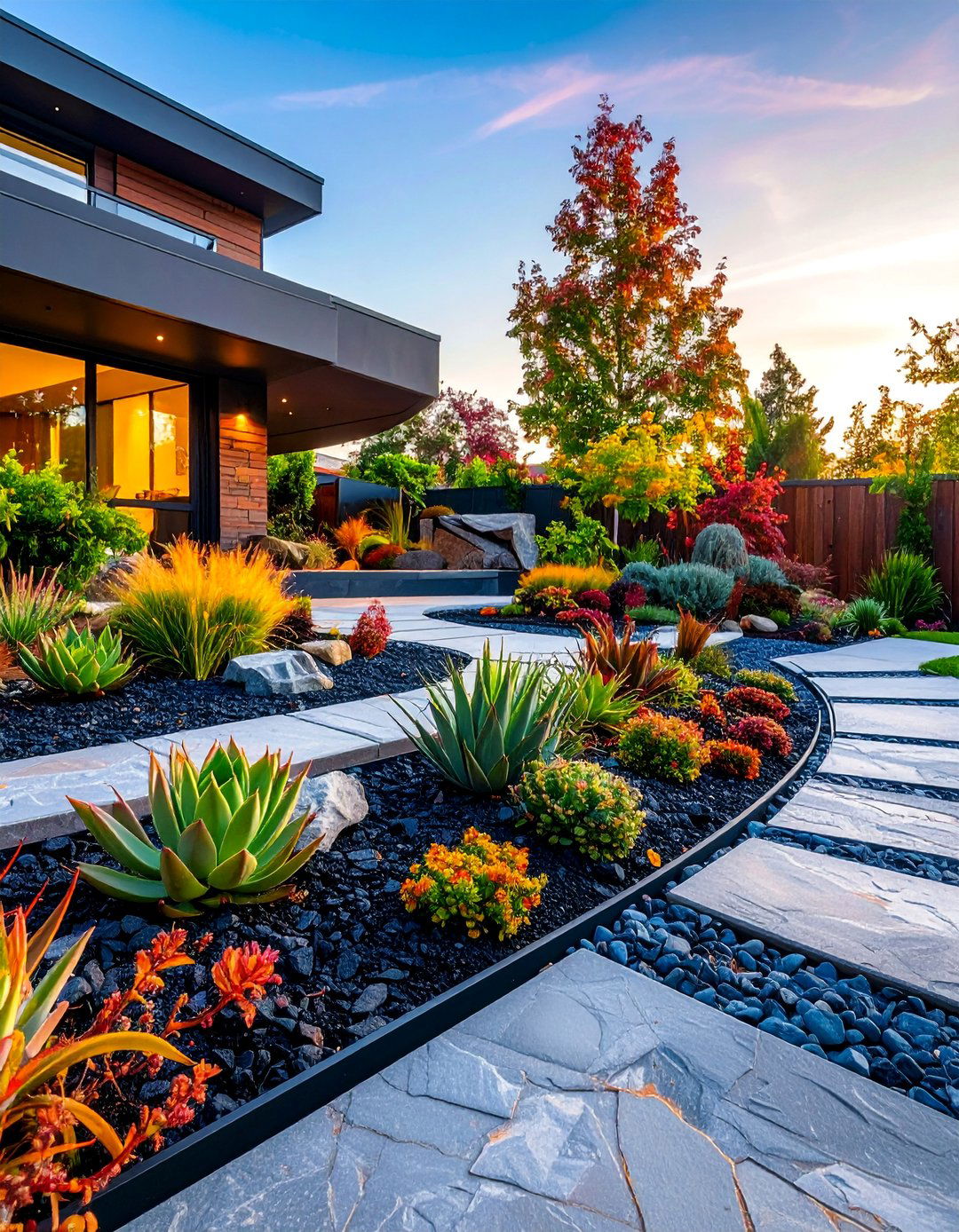
Design a contemporary front yard featuring geometric patterns created with different colored decorative stones and vibrant mulch sections. Angular limestone blocks define raised planting beds filled with drought-tolerant succulents, while crushed black lava rock creates bold pathways between areas. Bright red cedar mulch highlights specific plant groupings, creating striking color contrasts against the neutral stone palette. Architectural plants like yucca and ornamental grasses provide vertical interest without overwhelming the clean lines. Steel edging maintains crisp boundaries between materials, while integrated LED strip lighting emphasizes the geometric patterns after dark for a sophisticated urban aesthetic.
4. Cottage Garden Border with Mixed River Rocks

Establish charming cottage-style borders using a combination of smooth river rocks in various sizes as edging, with organic bark mulch filling planted areas. This design features curved, natural-looking boundaries that guide the eye through informal groupings of perennials and flowering shrubs. Larger specimen rocks serve as anchors for plant compositions, while smaller pebbles create transitions between mulched beds and gravel pathways. Native wildflowers and herbs scattered throughout the design attract pollinators and add seasonal color. The informal arrangement mimics natural stream beds, creating a relaxed, countryside atmosphere that complements traditional home styles beautifully.
5. Mediterranean Hillside Terracing with Stone Walls

Create dramatic elevation changes using stacked natural stone retaining walls filled with drought-resistant Mediterranean plants and topped with gravel mulch. This design incorporates multiple levels connected by stone steps, with each terrace featuring different plant themes. Lavender, rosemary, and ornamental grasses cascade over wall edges, while decomposed granite paths wind between levels. Olive trees or citrus provide shade and structure, surrounded by aromatic herbs in beds mulched with light-colored crushed stone. The layered approach maximizes planting space on slopes while creating visual interest and preventing erosion, perfect for homes with challenging topography.
6. Alpine Rock Garden with Evergreen Accents
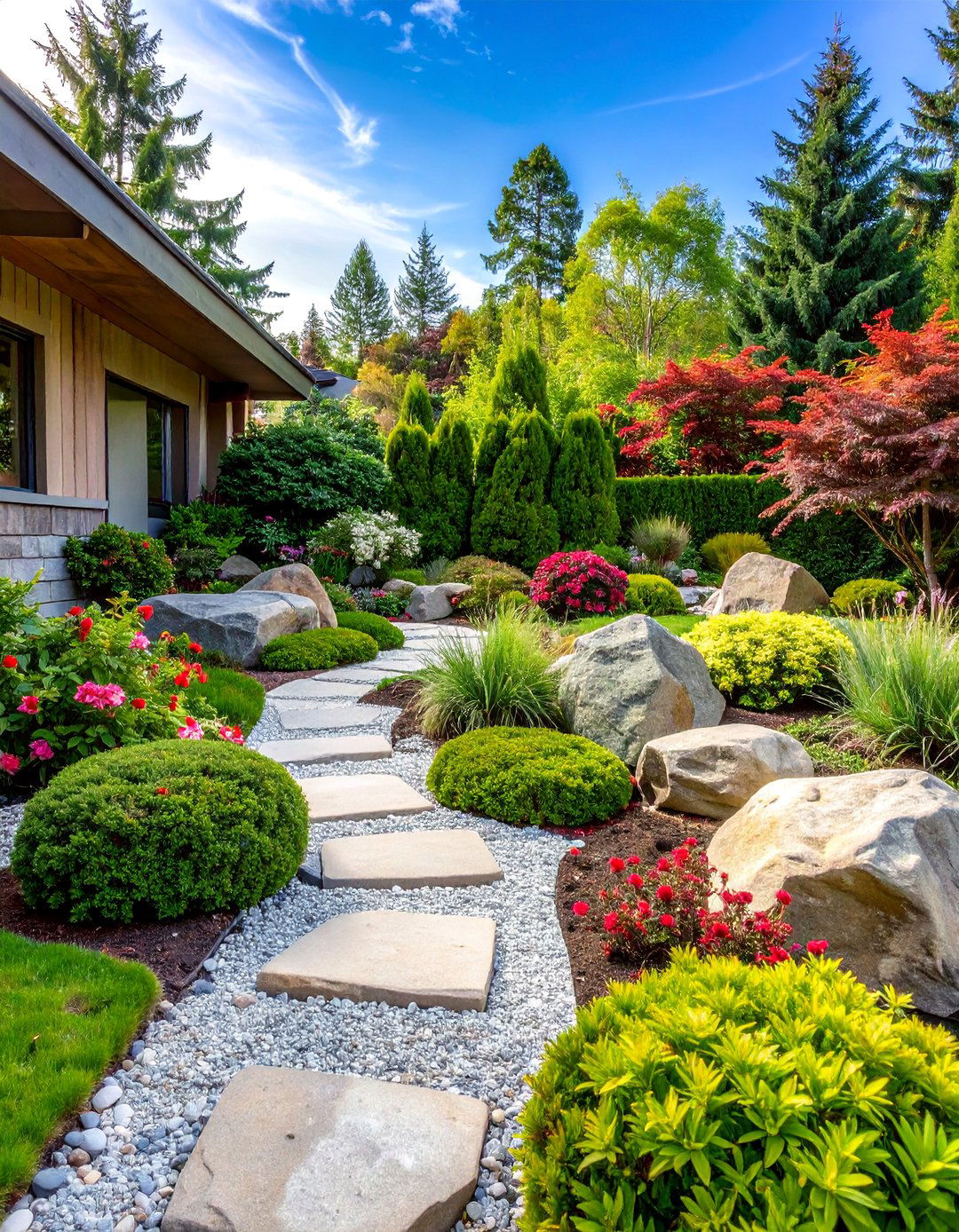
Develop a mountain-inspired landscape using large fieldstone boulders arranged in natural groupings, interplanted with hardy alpine perennials and dwarf evergreen shrubs. This design mimics high-altitude environments with excellent drainage provided by gravel mulch and strategically placed rocks. Creeping phlox, sedum, and other rock garden favorites fill crevices between stones, while small conifers provide year-round structure. Pine bark mulch surrounds larger plantings to retain moisture and suppress weeds. The irregular stone placement creates microclimates for different plant needs, while meandering paths encourage exploration of this rugged, naturalistic landscape that requires minimal maintenance once established.
7. Contemporary Dry Creek Bed Design

Install a realistic dry creek bed using various sizes of river rocks to simulate natural water flow patterns, bordered by modern plantings and organic mulch. This design begins with larger boulders representing the source, transitioning to medium river rocks, and ending with smaller pebbles that suggest water flow. Ornamental grasses and sedges planted along the "banks" create movement and natural texture. Dark shredded hardwood mulch surrounds the rock river, providing contrast and moisture retention for plantings. During rainfall, this feature functions as attractive drainage while adding year-round visual interest with its flowing lines and natural materials.
8. Tropical Paradise with Lava Rock Accents
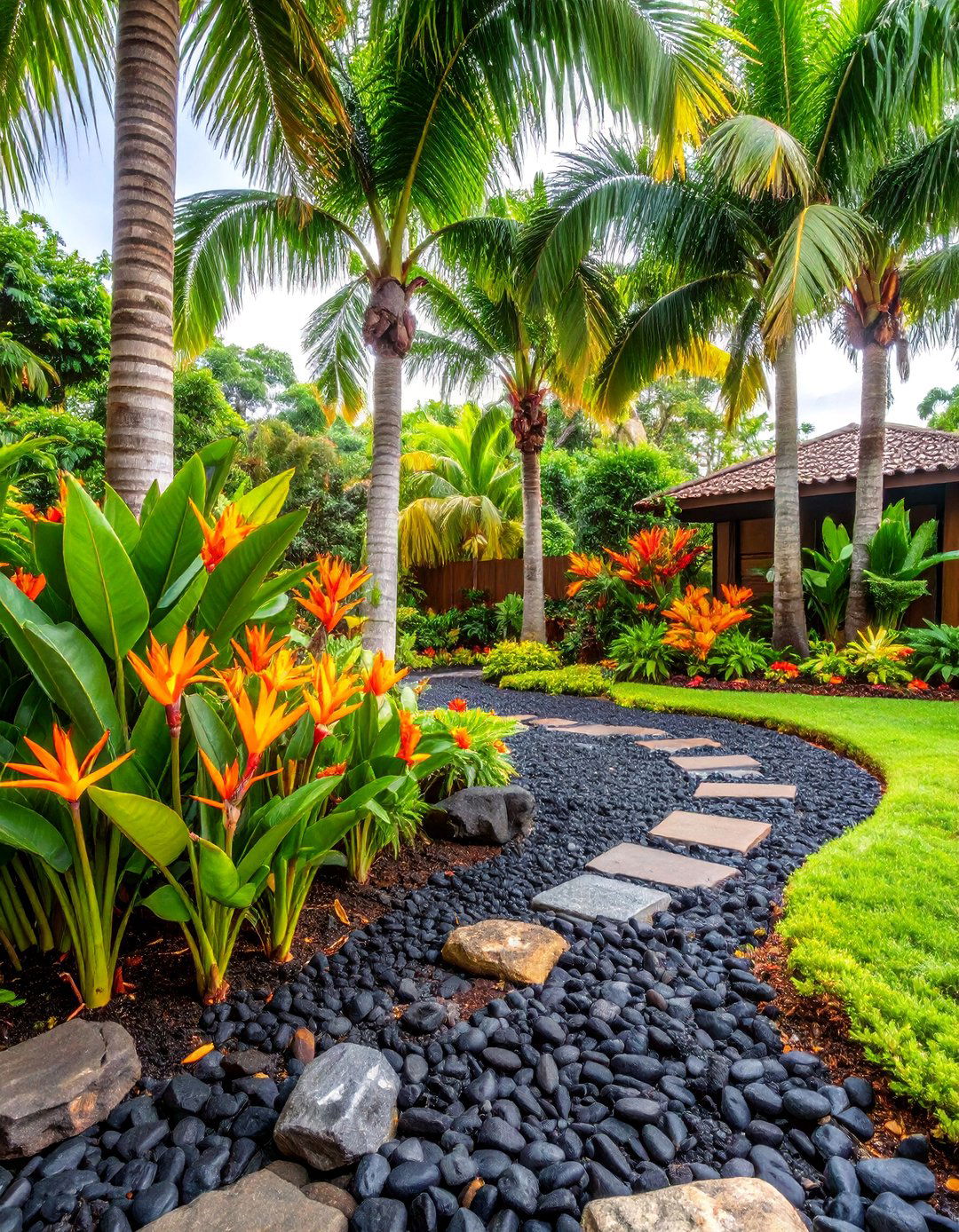
Create an exotic tropical atmosphere using black lava rock as dramatic contrast against lush green foliage and colorful organic mulch. This design features bold architectural plants like bird of paradise, palms, and giant elephant ears surrounded by rich, dark mulch that retains moisture in the humid microclimate. Red lava rock pathways wind through the planting areas, while larger lava boulders serve as sculptural focal points. The porous nature of lava rock provides excellent drainage while its dark color intensifies the vibrant greens of tropical foliage. Uplighting creates dramatic shadows and highlights the textural contrasts between smooth leaves and rough volcanic stone.
9. Prairie Style Naturalistic Planting

Design a native prairie landscape using local fieldstone and natural mulch materials to support indigenous grasses and wildflowers. This sustainable approach features irregular stone placement that mimics natural rock outcroppings, with native bunch grasses and prairie flowers filling the spaces between. Locally sourced wood chip mulch suppresses weeds while allowing natural plant succession and self-seeding. Seasonal changes provide continuous interest as different species bloom throughout the growing season. The loose, naturalistic arrangement requires minimal maintenance while supporting local wildlife and adapting to regional climate conditions. This eco-friendly design celebrates local ecosystems while creating beautiful, evolving landscapes.
10. English Cottage Stone Wall Garden
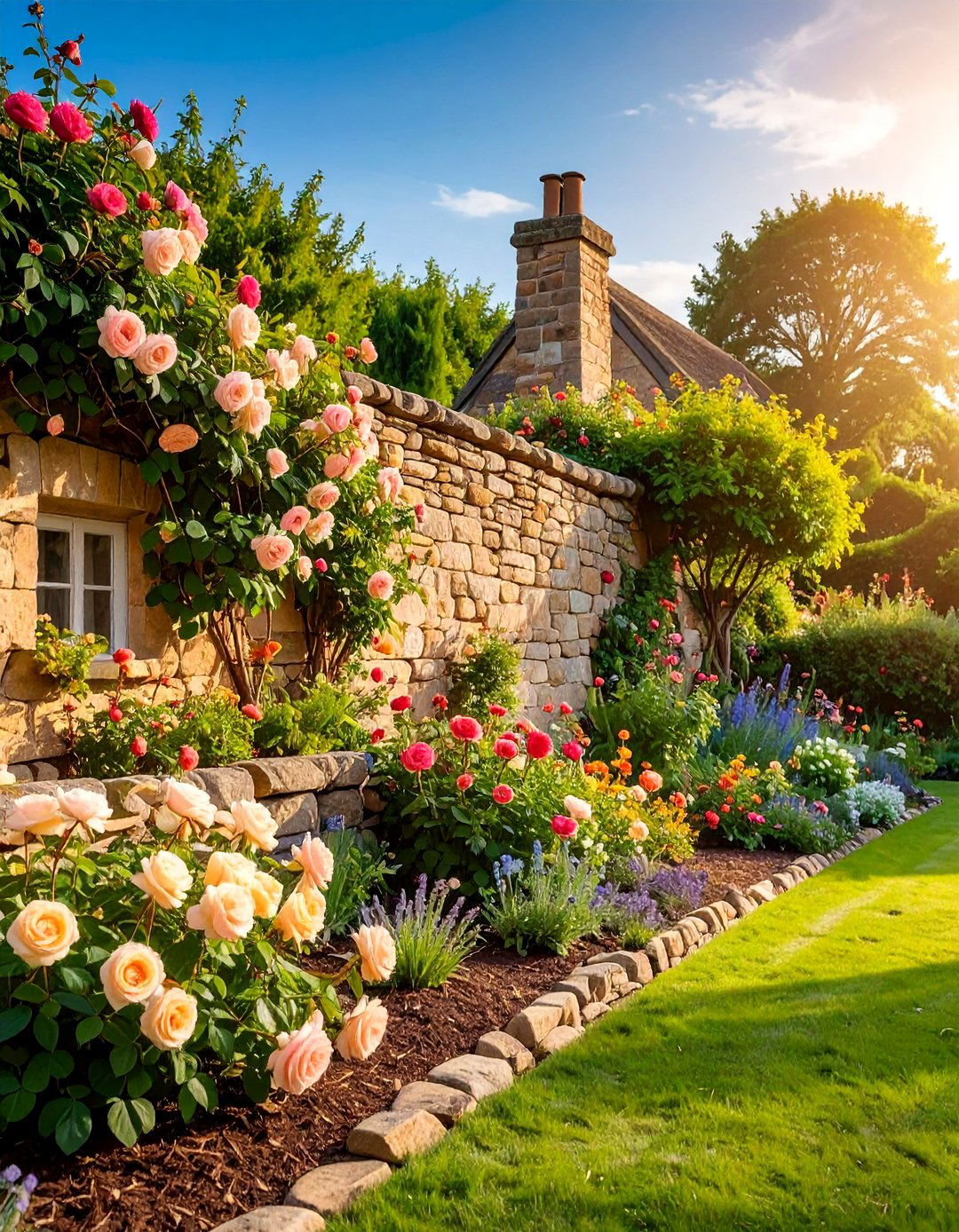
Construct traditional dry-stacked stone walls using local limestone or fieldstone, filled with cottage garden favorites and topped with organic mulch. This classic design features irregular stones fitted together without mortar, creating planting pockets for trailing plants and small perennials. Climbing roses and clematis cascade over wall sections, while lavender and catmint spill from crevices. Bark mulch in planting beds retains moisture for more demanding plants like delphiniums and hollyhocks. The weathered stone develops character over time as lichens and mosses naturally establish, creating an aged appearance that complements traditional architecture and formal garden styles.
11. Succulent Showcase with Decorative Gravel

Feature an extensive collection of succulents using colorful decorative gravel as both mulch and design element, accented with sculptural rock formations. This water-wise design incorporates various succulent shapes, sizes, and colors arranged in flowing patterns across beds of rose-colored crushed granite. Larger specimens like agave and barrel cacti anchor the composition, while smaller echeveria and sedums create intricate ground-level mosaics. Specimen boulders provide vertical interest and thermal mass for plant protection. The gravel mulch prevents root rot while reflecting light to enhance succulent colors. This low-maintenance design thrives in sunny locations with minimal water requirements.
12. Formal Parterre with Stone Edging

Create an elegant formal garden using precisely cut stone edging to define geometric planting beds filled with structured plantings and contrasting mulch colors. This symmetrical design features boxwood hedges, ornamental grasses, and seasonal annuals arranged in traditional parterre patterns. Light-colored crushed limestone pathways separate beds mulched with dark cocoa bark, creating strong visual contrast. Corner plantings of topiary evergreens provide vertical anchors, while seasonal color comes from carefully planned bulb and annual displays. The formal structure requires regular maintenance but provides year-round elegance and sophisticated curb appeal that complements classical architecture styles.
13. Woodland Shade Garden with Natural Stone
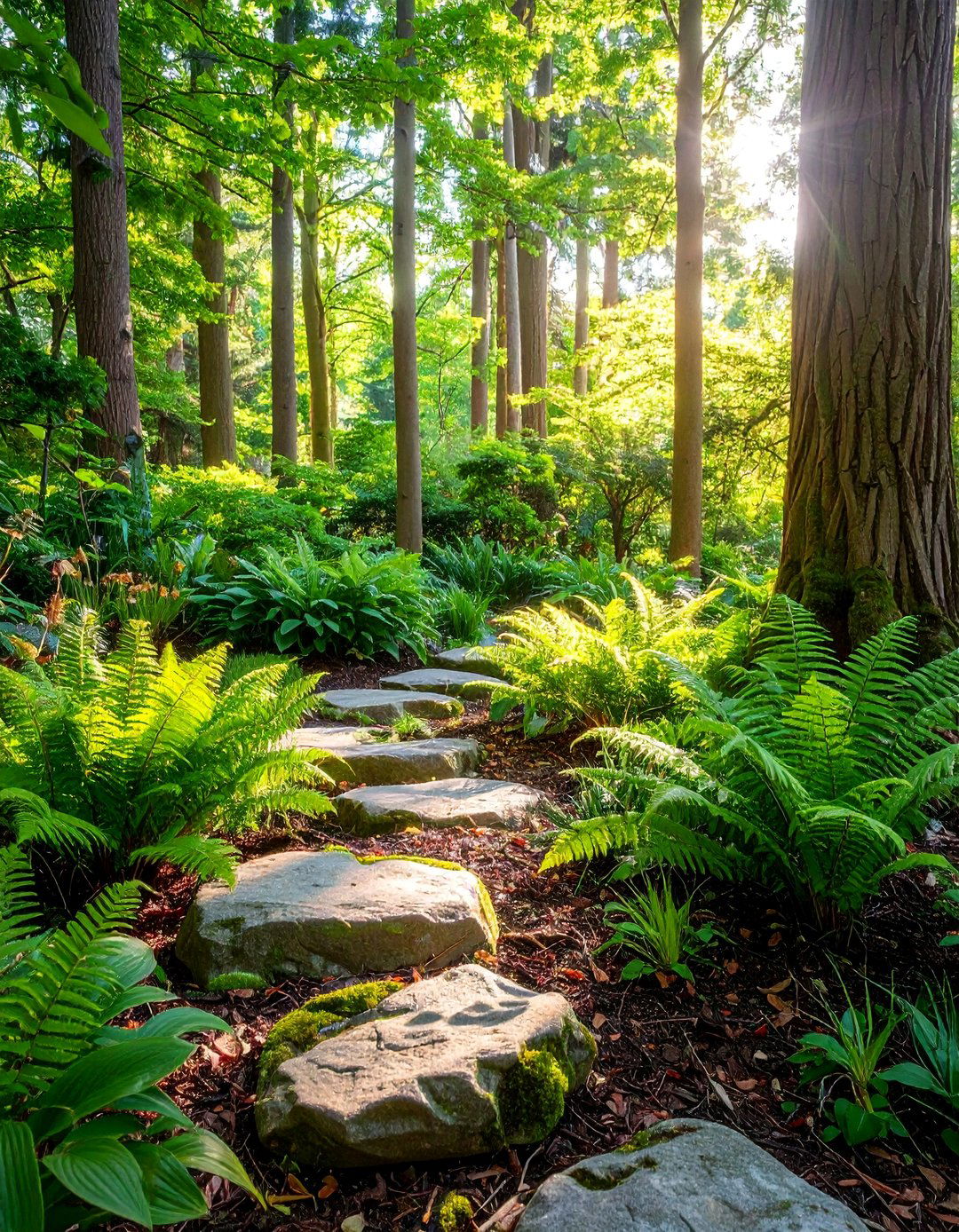
Develop a naturalistic woodland setting using native fieldstone and organic mulch to support shade-loving plants in a forest-like environment. This design incorporates irregular stone placement that suggests natural rock outcroppings, with ferns, hostas, and wild ginger planted in pockets of rich leaf mold mulch. Larger stones serve as natural seating and focal points, while smaller rocks create drainage and planting crevices. Native trees provide canopy, with understory shrubs and groundcovers creating layers of interest. The organic approach encourages natural plant establishment while providing habitat for woodland creatures. This low-maintenance design thrives in shaded locations with minimal water requirements.
14. Coastal Dune Landscape with Shell Accents

Capture the essence of coastal environments using sand-colored decomposed granite, driftwood-style rocks, and shell mulch to support salt-tolerant plants. This design features wind-sculpted grasses, sea lavender, and other coastal natives planted among weathered boulders that suggest natural beach formations. Crushed shell mulch provides alkaline conditions preferred by many coastal plants while reflecting light and creating textural interest. The informal arrangement mimics natural dune systems, with plants arranged in drifts that appear naturally established. This design thrives in windy, sandy conditions while providing year-round structure and seasonal interest from native coastal plant communities.
15. Urban Rooftop Garden with Lightweight Materials

Design a rooftop or raised garden using lightweight expanded shale and engineered mulch products to minimize structural load while maximizing visual impact. This contemporary design features large lightweight artificial boulders as focal points, surrounded by drought-tolerant plants in beds of rubber mulch or lightweight bark alternatives. Expanded shale provides excellent drainage while weighing significantly less than traditional stone. Ornamental grasses and succulents thrive in the challenging rooftop environment, while built-in irrigation ensures plant health. The modern materials and clean lines complement contemporary architecture while creating usable outdoor space in urban environments with weight restrictions.
16. Rain Garden with Permeable Stone Mulch
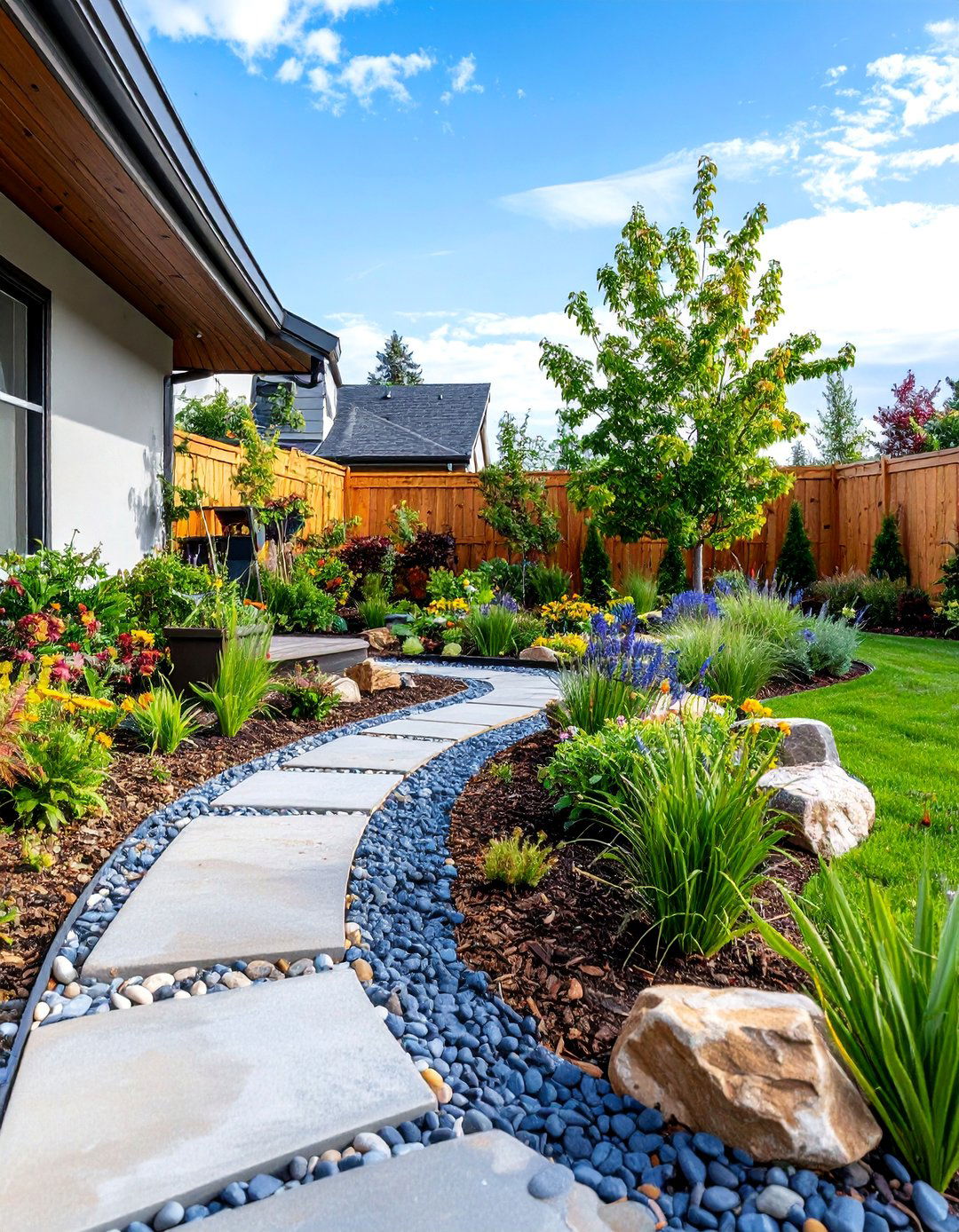
Create a functional rain garden using permeable stone mulch and strategically placed rocks to manage stormwater runoff while supporting water-loving plants. This design features a gently sloped basin lined with river rocks and filled with plants that tolerate both wet and dry conditions. Permeable gravel mulch allows rapid water infiltration while preventing erosion during heavy rains. Native sedges, irises, and other water-adapted plants provide seasonal interest and wildlife habitat. Larger rocks create visual interest and provide thermal mass for plant protection. This environmentally beneficial design reduces runoff while creating attractive, functional landscapes that change character with weather patterns.
17. Butterfly Garden with Nectar Plant Focus
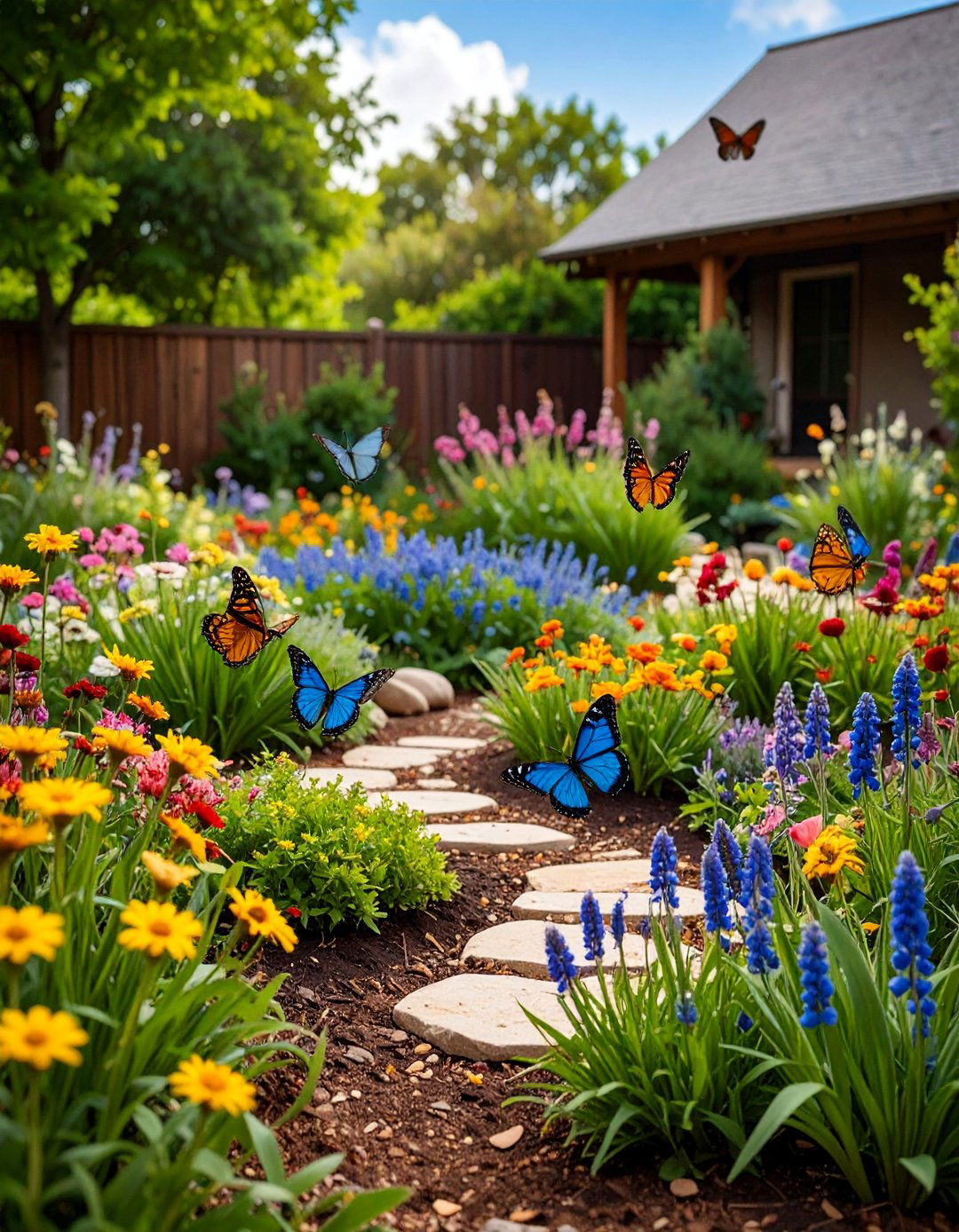
Design a specialized butterfly habitat using warm-colored stones and organic mulch to support nectar-rich flowering plants throughout the growing season. This design features limestone rocks that provide sunny basking spots for butterflies, surrounded by plantings of native wildflowers, herbs, and butterfly-attracting shrubs. Rich compost mulch supports heavy-feeding flowering plants while retaining moisture during dry periods. The informal arrangement includes seasonal succession of blooms from early spring through late fall. Host plants for butterfly larvae are strategically placed among nectar sources. This wildlife-friendly design provides continuous seasonal interest while supporting local pollinator populations and creating educational opportunities for families.
18. Herb Garden Spiral with Stone Construction

Construct a classic herb spiral using stacked fieldstone to create microclimates for different herb growing requirements, filled with appropriate mulch for each zone. This design features a spiral mound with Mediterranean herbs at the sunny, well-drained top, transitioning to moisture-loving herbs at the base. Crushed limestone mulch at the peak provides alkaline conditions for lavender and rosemary, while organic compost mulch at the bottom supports basil and parsley. The stone construction provides thermal mass and excellent drainage, while the spiral design maximizes growing space in a compact footprint. This functional and beautiful design provides fresh herbs while creating an attractive focal point.
19. Gravel Garden with Architectural Plants
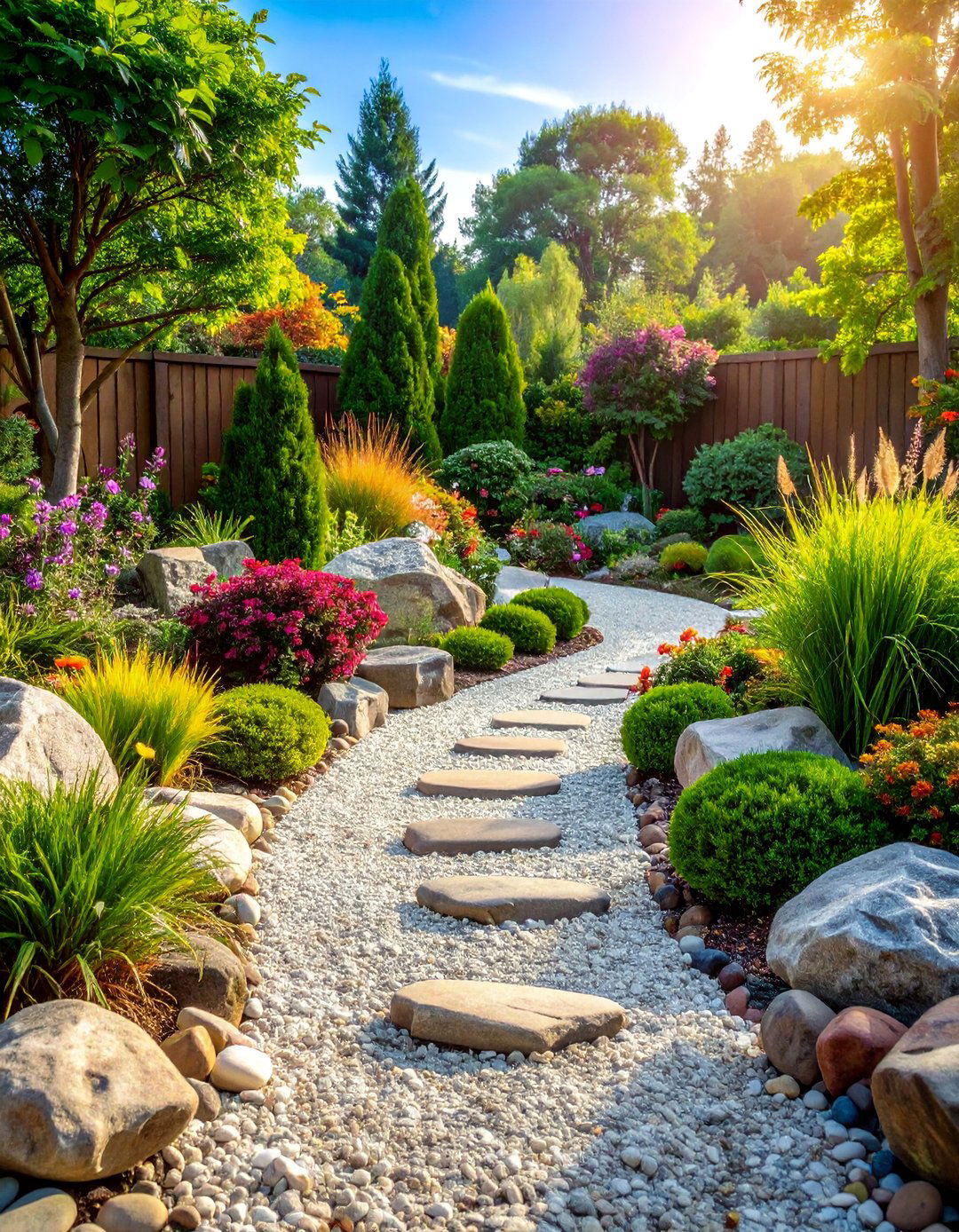
Develop a sophisticated gravel garden using fine decorative stone as the primary ground cover, punctuated by architectural plants and specimen boulders for dramatic effect. This contemporary design features bold foliage plants like yucca, ornamental grasses, and sculptural succulents emerging from beds of uniform gravel mulch. Large weathered boulders provide focal points and contrast with the fine-textured ground cover. The monochromatic gravel palette allows plant forms and textures to dominate the design, while excellent drainage supports a wide variety of drought-tolerant species. This low-maintenance approach creates year-round interest with minimal water requirements and sophisticated modern appeal.
20. Victorian Garden Border with Period-Appropriate Materials
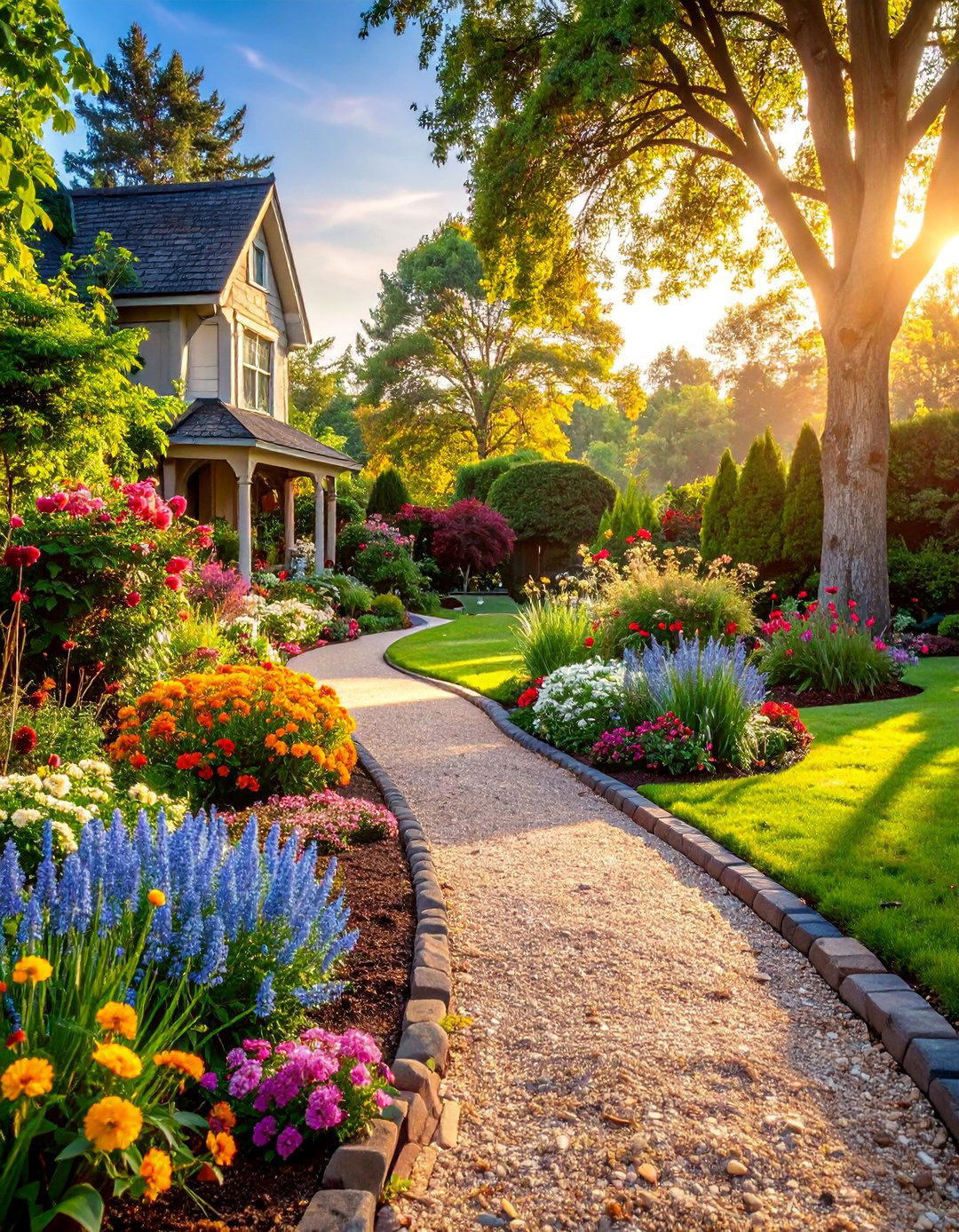
Recreate authentic Victorian garden styling using traditional materials like slate chips, brick edging, and organic mulch to frame formal bedding displays. This historical design features geometric patterns outlined with slate or brick, filled with seasonal bedding plants and finished with fine bark mulch. Cast iron or stone ornaments provide period authenticity, while box hedging creates formal structure. The elaborate design includes carpet bedding techniques using colorful foliage plants arranged in intricate patterns. Traditional roses and cottage garden perennials provide familiar Victorian charm. This high-maintenance but rewarding design creates authentic historical landscapes that complement period architecture and formal garden traditions.
21. Children's Discovery Garden with Safe Materials
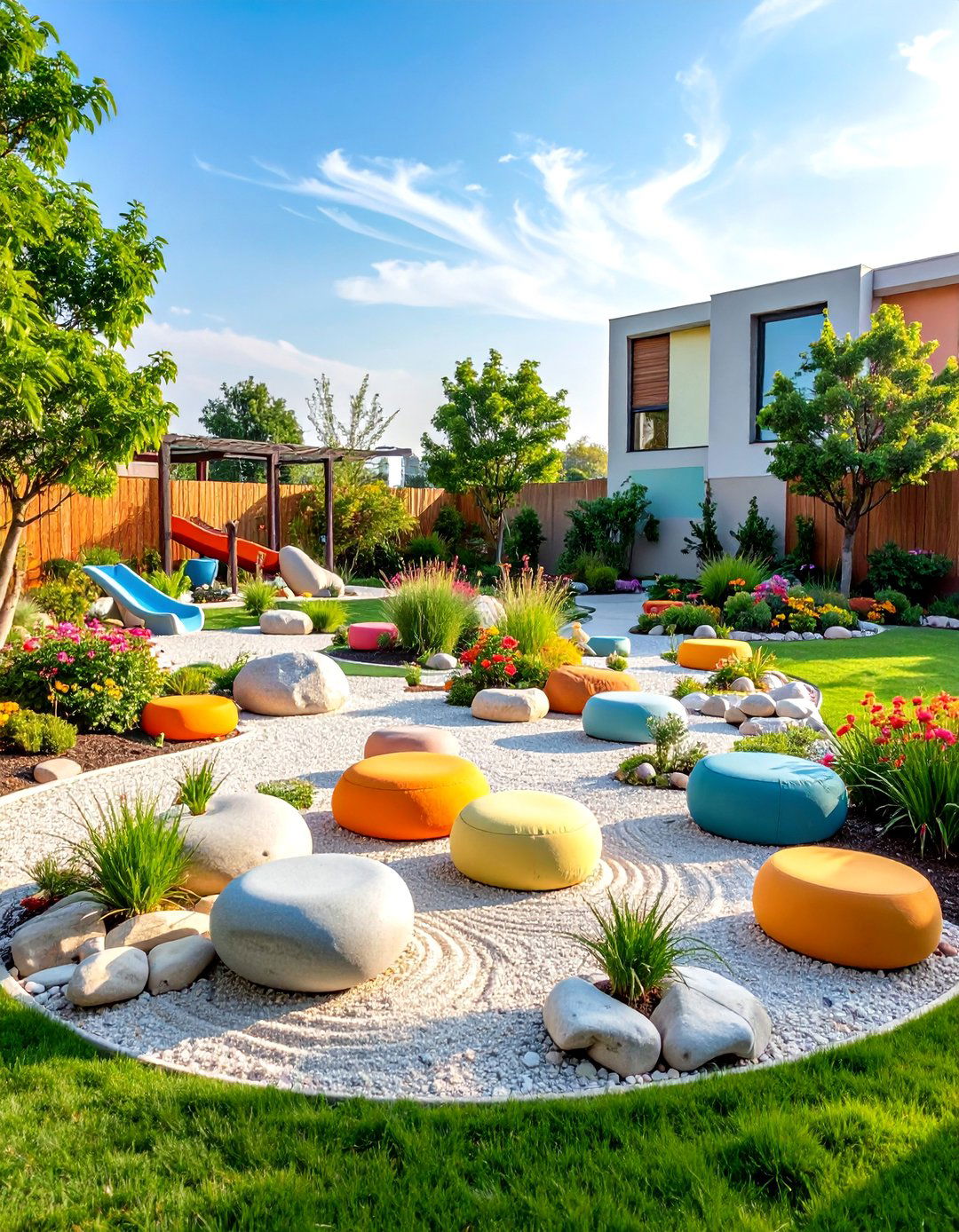
Create an engaging children's garden using smooth, rounded stones and organic mulch to provide safe exploration opportunities while teaching about nature. This design features large, stable boulders for climbing and seating, with sensory plants like lamb's ear and ornamental grasses providing textural experiences. Certified playground mulch ensures safety around play areas, while child-height plantings encourage interaction and observation. The design includes hidden treasures like colorful stones and educational elements that encourage exploration. Native plants attract butterflies and birds for wildlife observation, while edible plants provide learning opportunities about food production. This family-friendly design grows with children while providing educational and recreational value.
22. Fire-Resistant Landscape with Mineral Mulch

Design a defensible landscape using fire-resistant materials and plants to protect property while maintaining aesthetic appeal in fire-prone regions. This practical design features mineral mulch like decomposed granite or gravel instead of flammable organic materials, with widely spaced, fire-resistant plants. Large rocks provide thermal mass and firebreaks, while succulent plants store water and resist ignition. The design eliminates continuous fuel loads while maintaining attractive landscaping through careful plant selection and spacing. Native fire-adapted plants recover quickly after disturbance, while stone elements provide permanent structure. This responsible approach balances beauty with fire safety in vulnerable areas.
23. Permaculture Food Forest with Stone Terracing
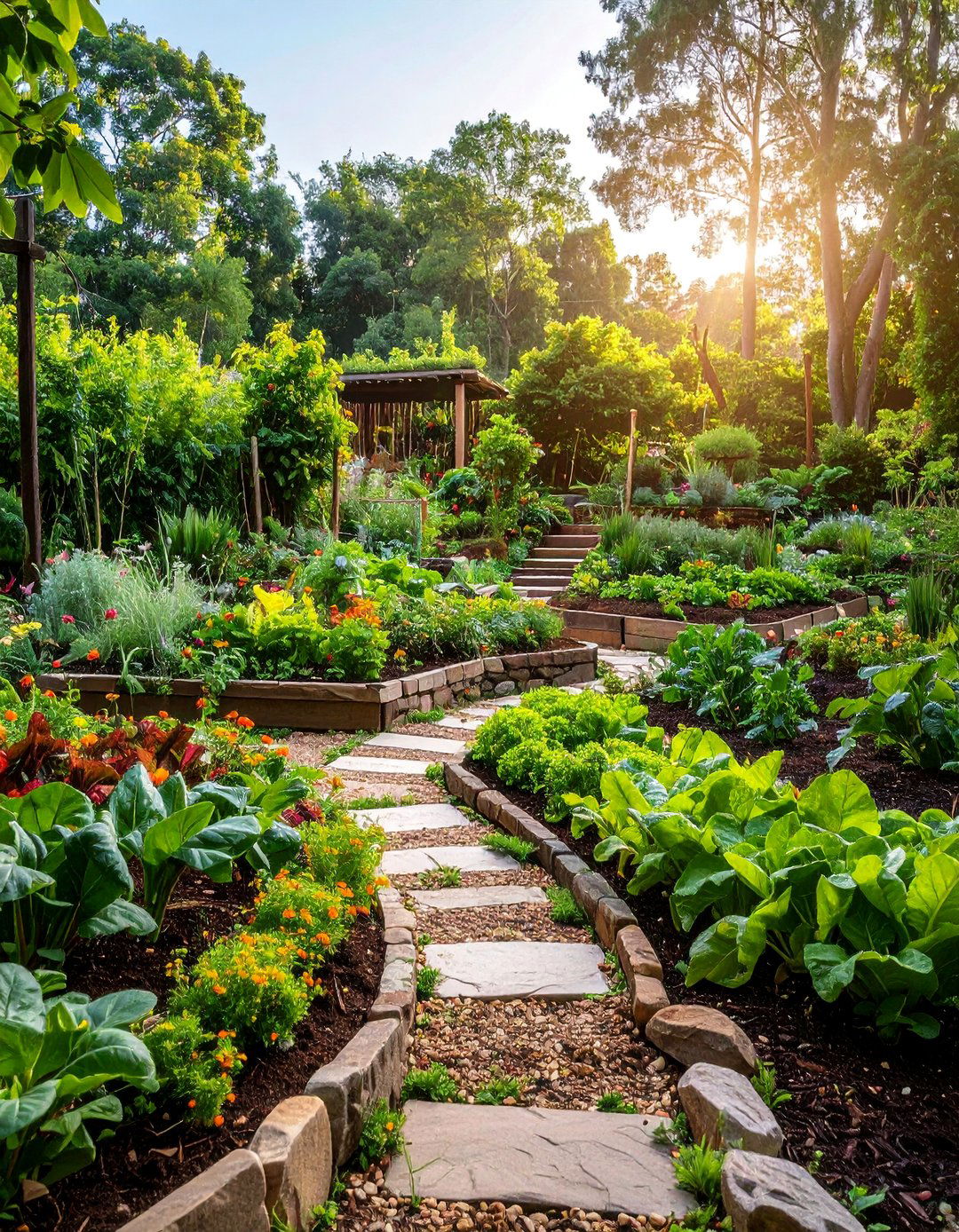
Establish a productive food forest using stone terracing and organic mulch to create sustainable, edible landscapes that mimic natural forest ecosystems. This design features multiple plant layers from canopy trees to ground covers, supported by stone retaining walls that create level planting areas. Organic mulch builds soil while suppressing weeds and retaining moisture for food production. The design includes nitrogen-fixing plants, beneficial insect habitat, and water harvesting features. Stone pathways provide access for harvesting while permanent materials reduce maintenance. This sustainable approach produces food while creating attractive, diverse landscapes that support biodiversity and soil health through ecological design principles.
24. Moonlight Garden with Reflective Elements

Create an enchanting nighttime garden using light-colored stones and plants with white or silver foliage for dramatic moonlight effects. This romantic design features white limestone rocks and silver-leaved plants like dusty miller, artemisia, and white-flowering specimens that glow in moonlight. Light-colored gravel mulch reflects available light while providing excellent drainage for Mediterranean plants. Evening-blooming flowers like four o'clocks and moonflowers add fragrance and attract night pollinators. Strategic landscape lighting enhances the ethereal quality while extending garden enjoyment into evening hours. This specialized design creates magical outdoor spaces perfect for evening entertaining and romantic garden experiences.
25. Climate-Adaptive Transition Garden

Design a flexible landscape that adapts to changing climate conditions using versatile stone and mulch combinations that support diverse plant communities. This forward-thinking design incorporates materials and plants that tolerate temperature extremes, drought, and flooding while maintaining year-round appeal. Stone elements provide permanent structure as plant communities evolve, while organic mulch builds soil resilience. The design includes both drought-tolerant and moisture-loving plants in different zones, connected by stone pathways and transitions. Native plant emphasis ensures local adaptation, while diverse material palette accommodates changing conditions. This resilient approach creates sustainable landscapes that remain beautiful while adapting to environmental changes.
Conclusion:
Front yard landscaping with rocks and mulch provides endless creative possibilities for homeowners seeking beautiful, sustainable, and low-maintenance outdoor spaces. These versatile materials adapt to any architectural style, climate condition, or personal preference while delivering practical benefits including improved drainage, weed suppression, and water conservation. From dramatic desert xeriscapes to tranquil Japanese zen gardens, from productive food forests to sophisticated contemporary designs, the combination of rocks and mulch creates lasting landscapes that evolve beautifully over time while requiring minimal ongoing maintenance and resource inputs.



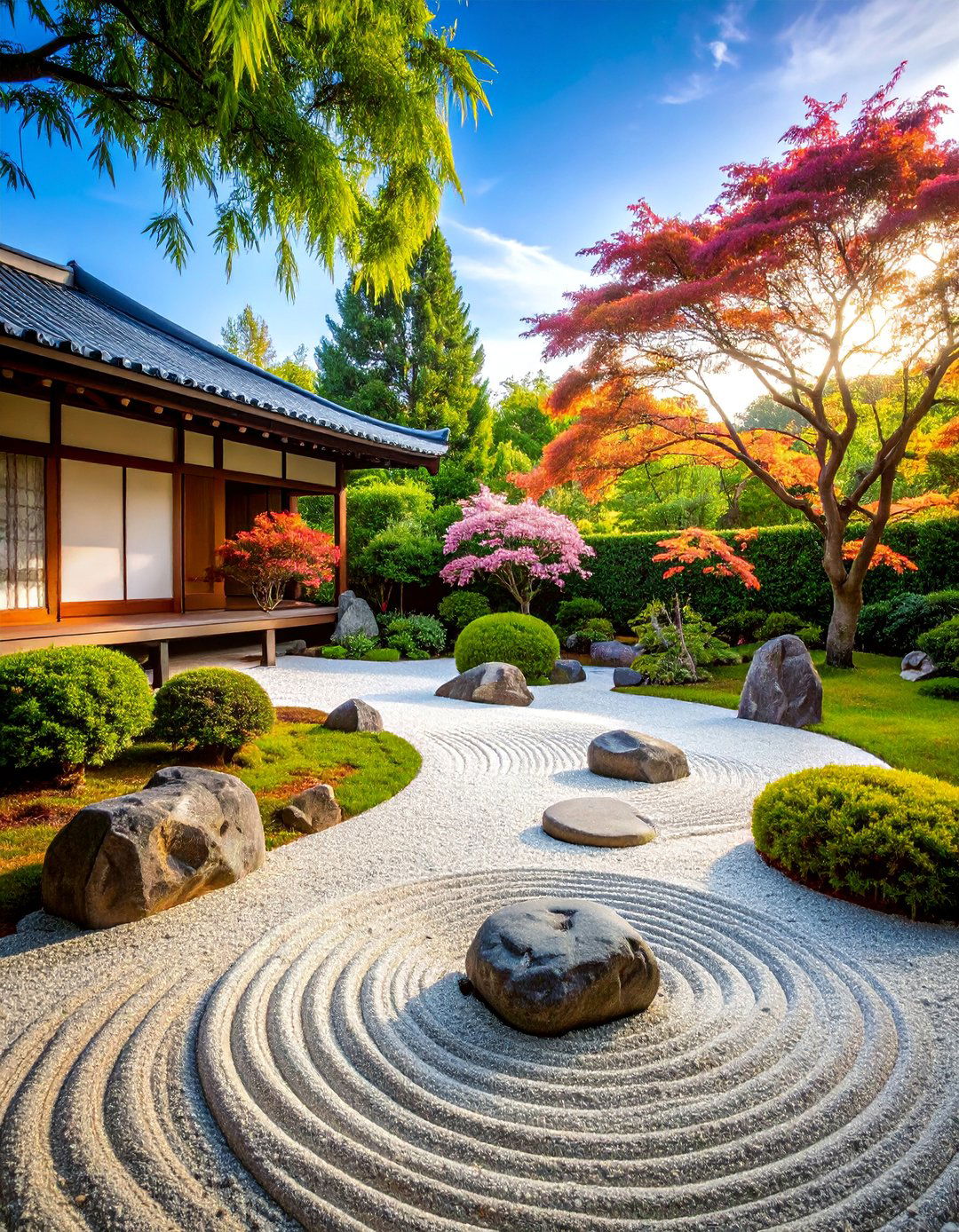
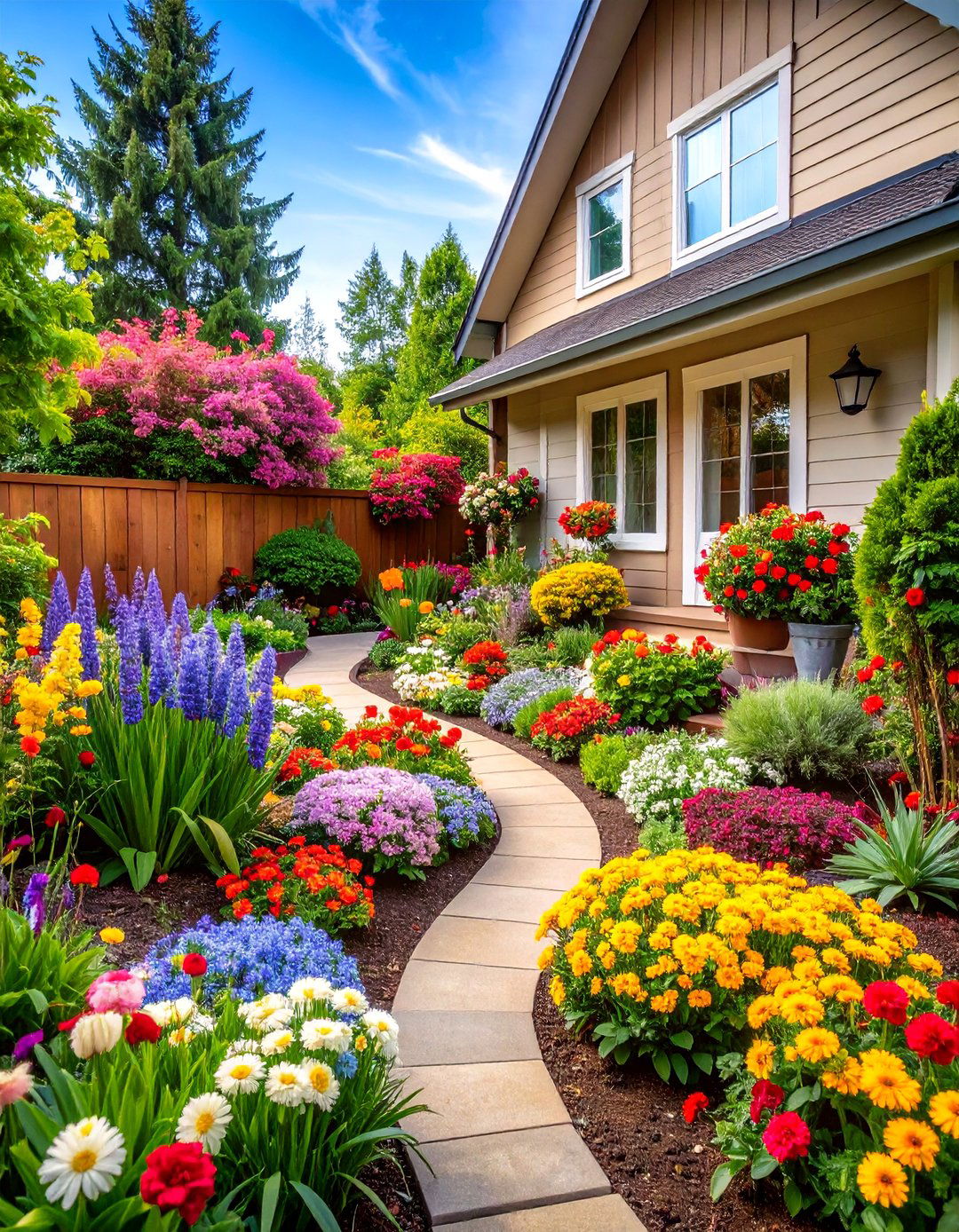
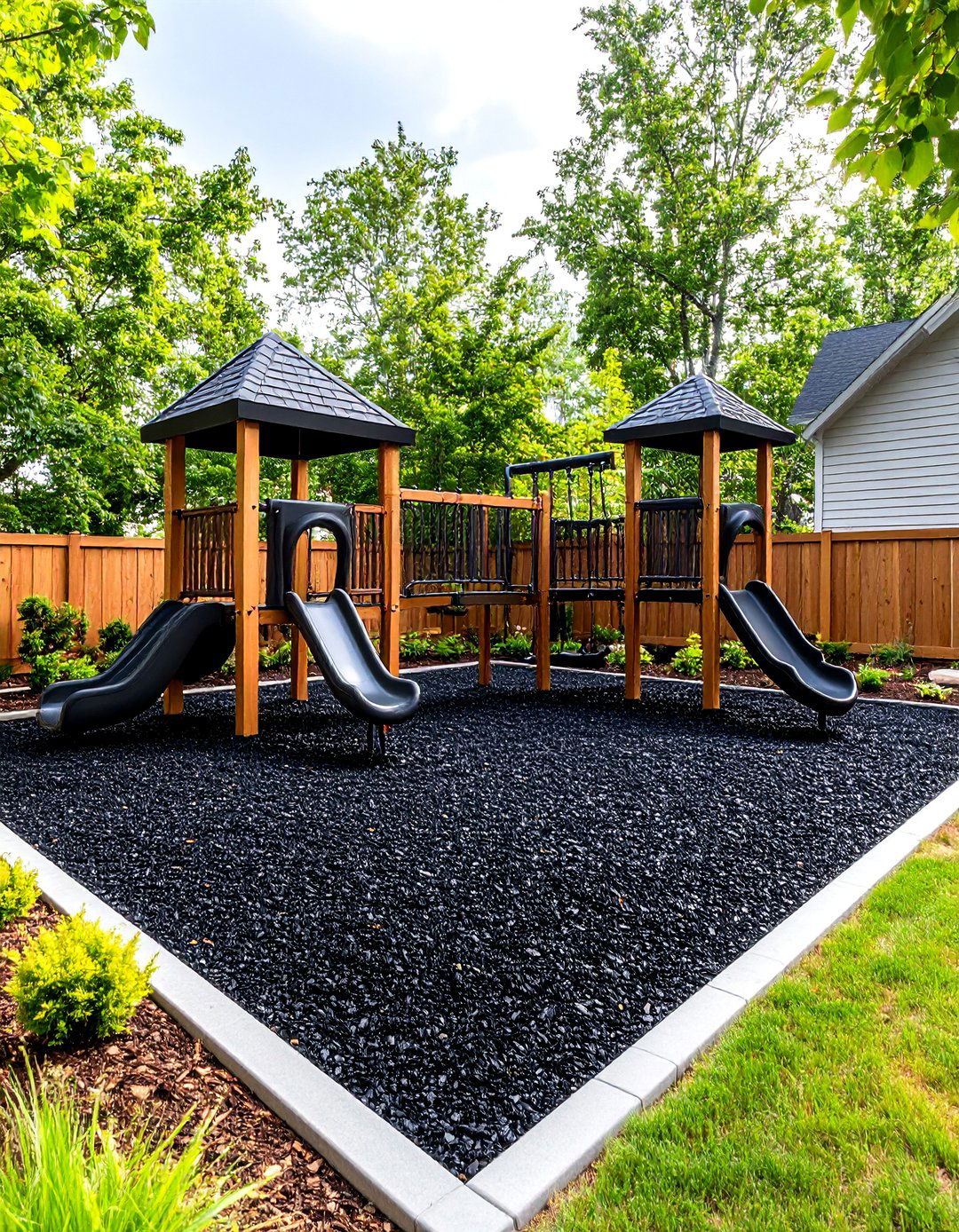

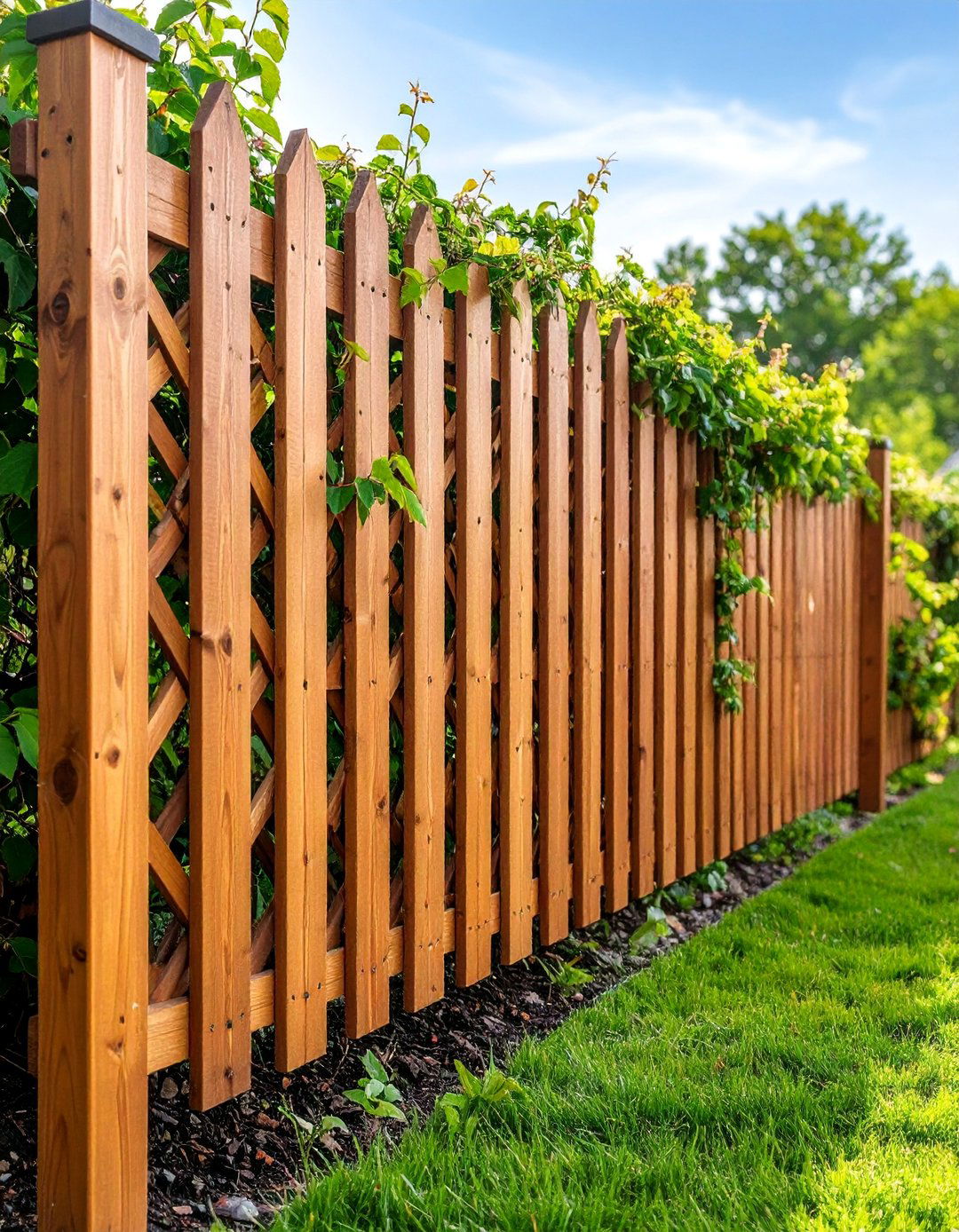
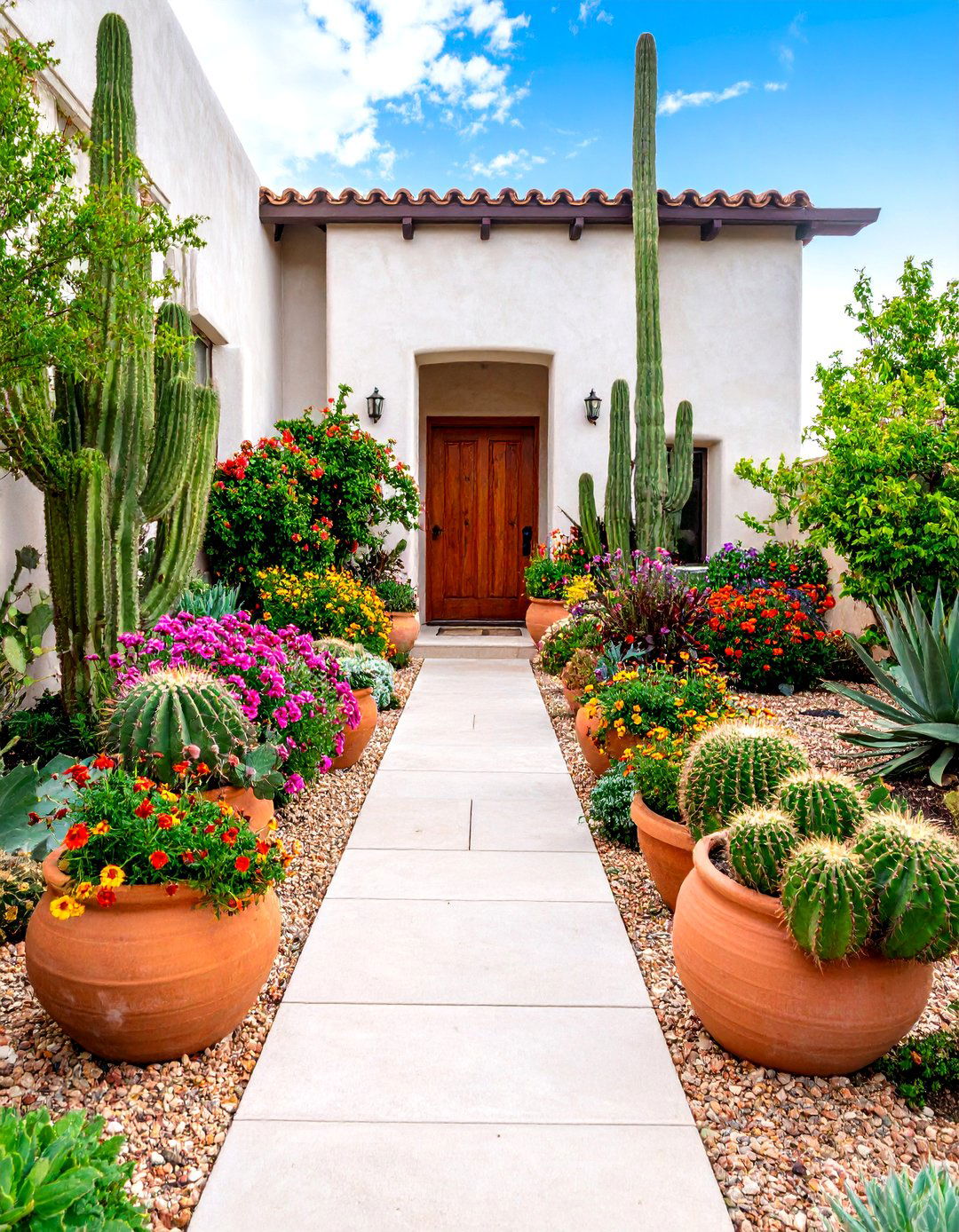
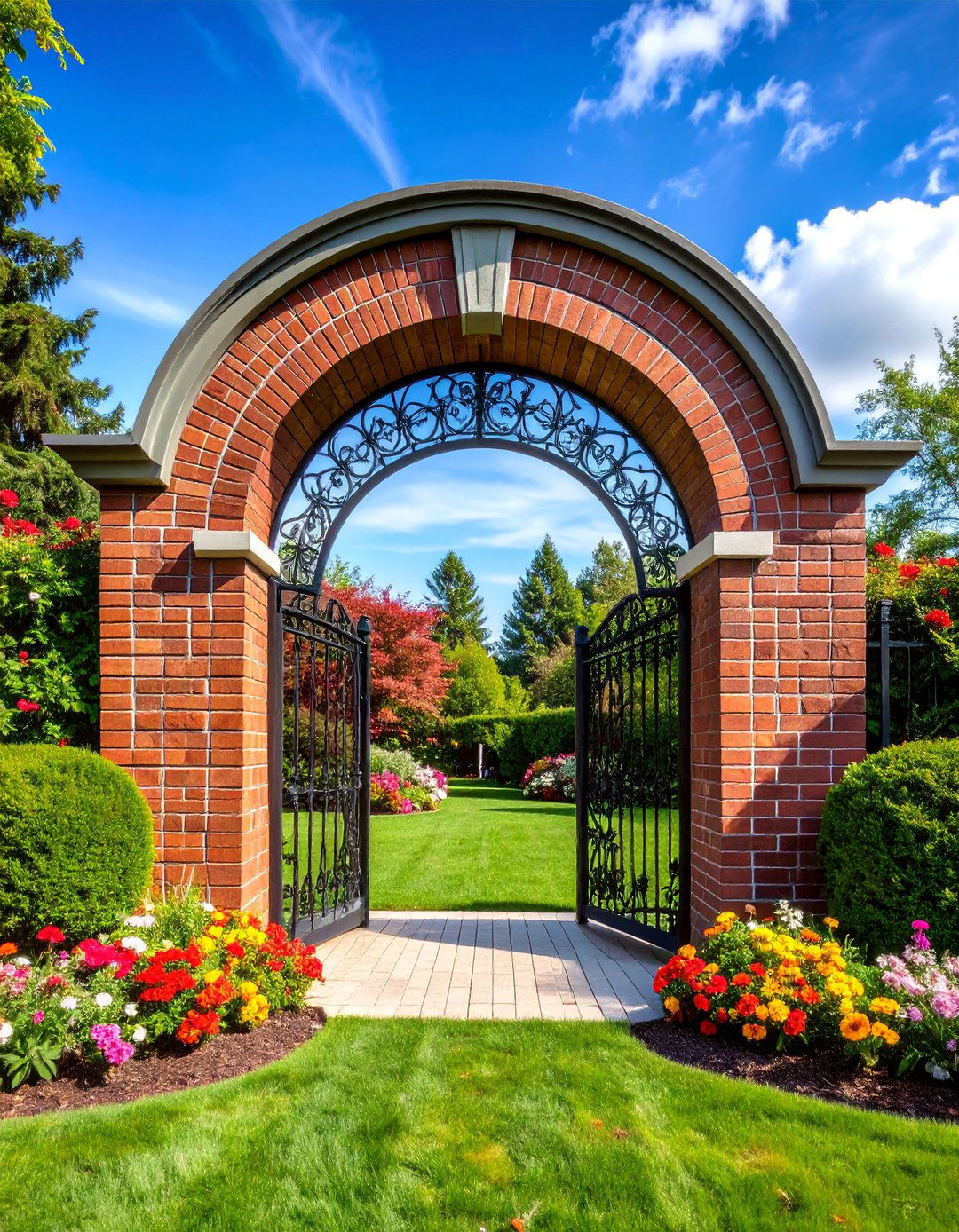

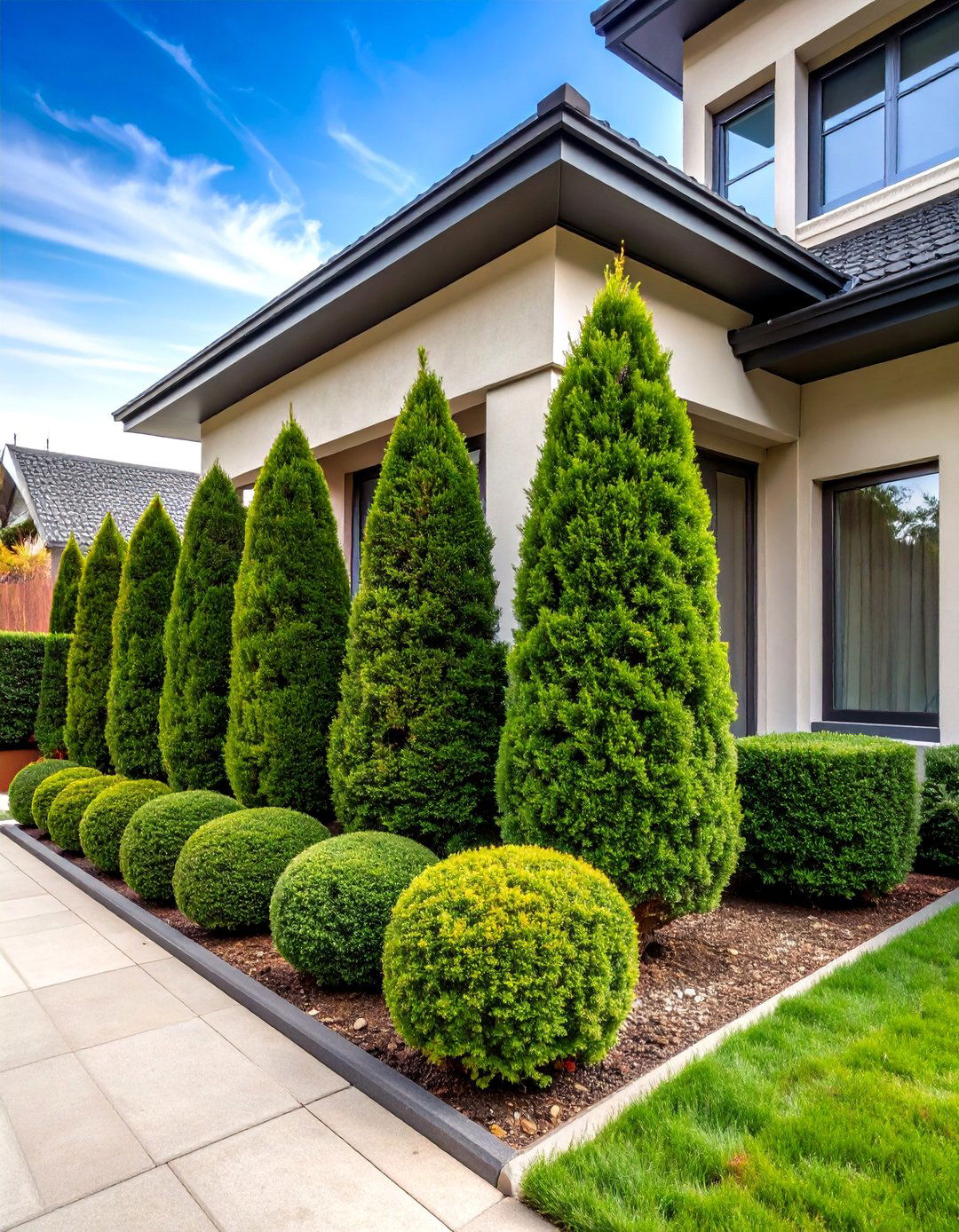
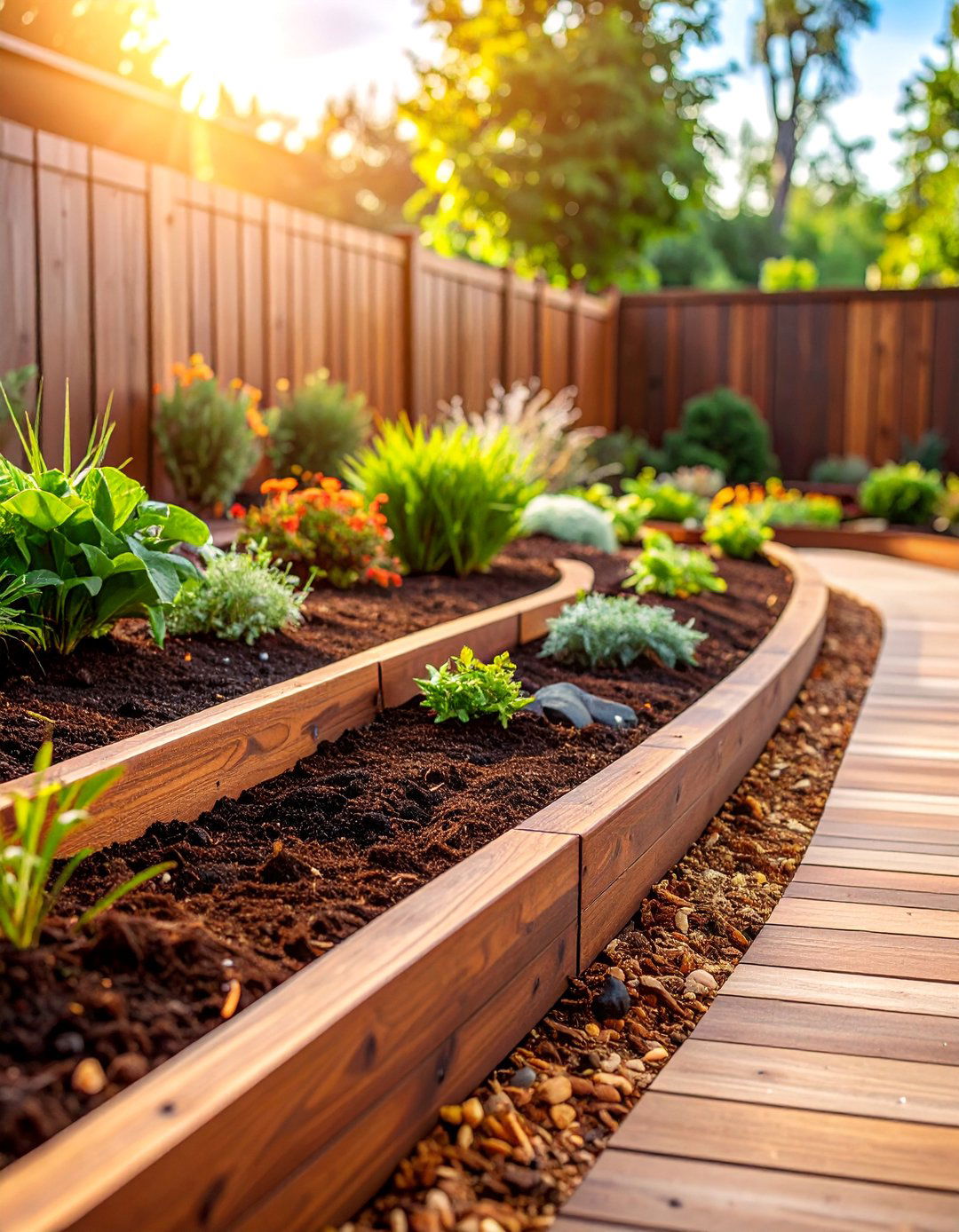
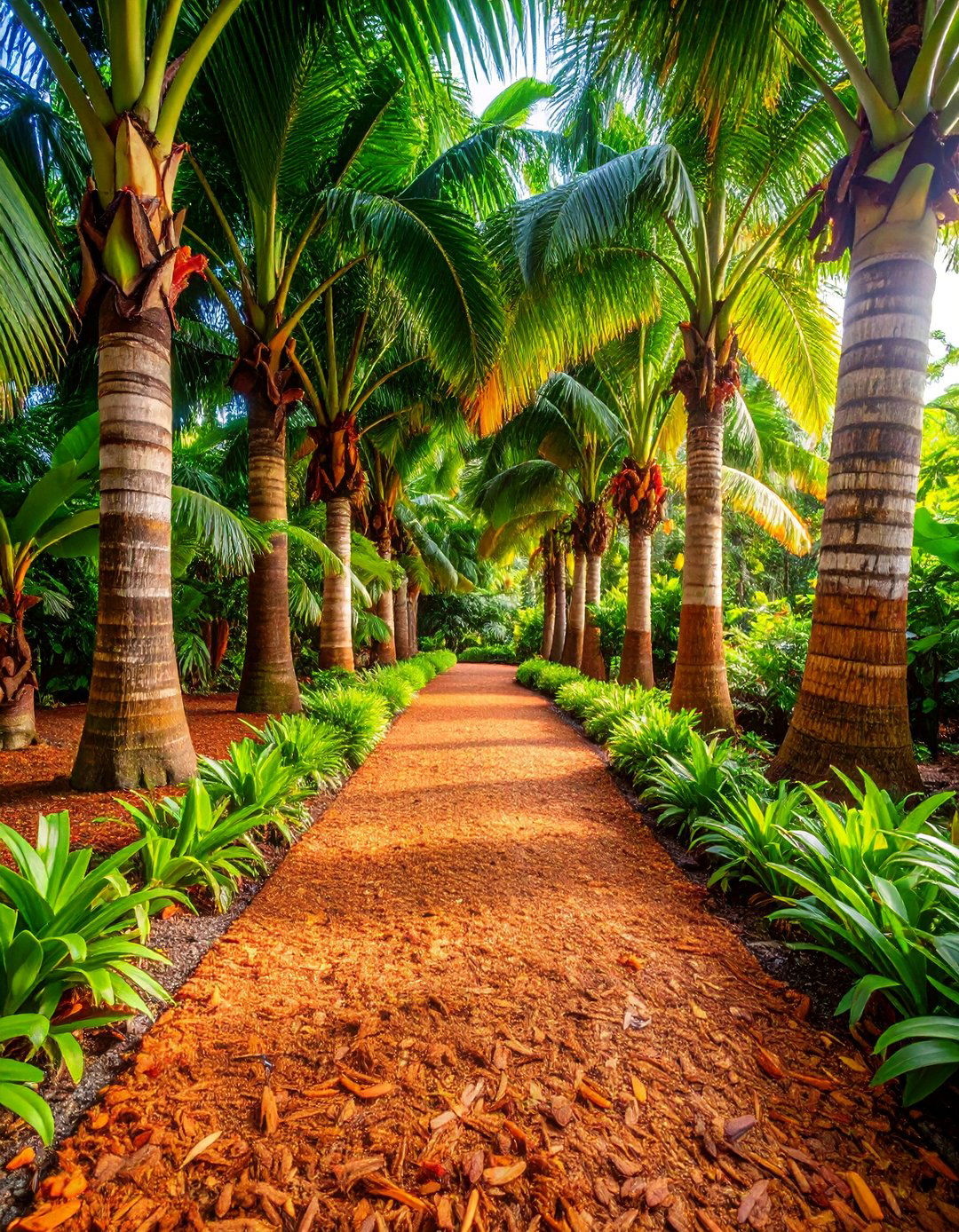

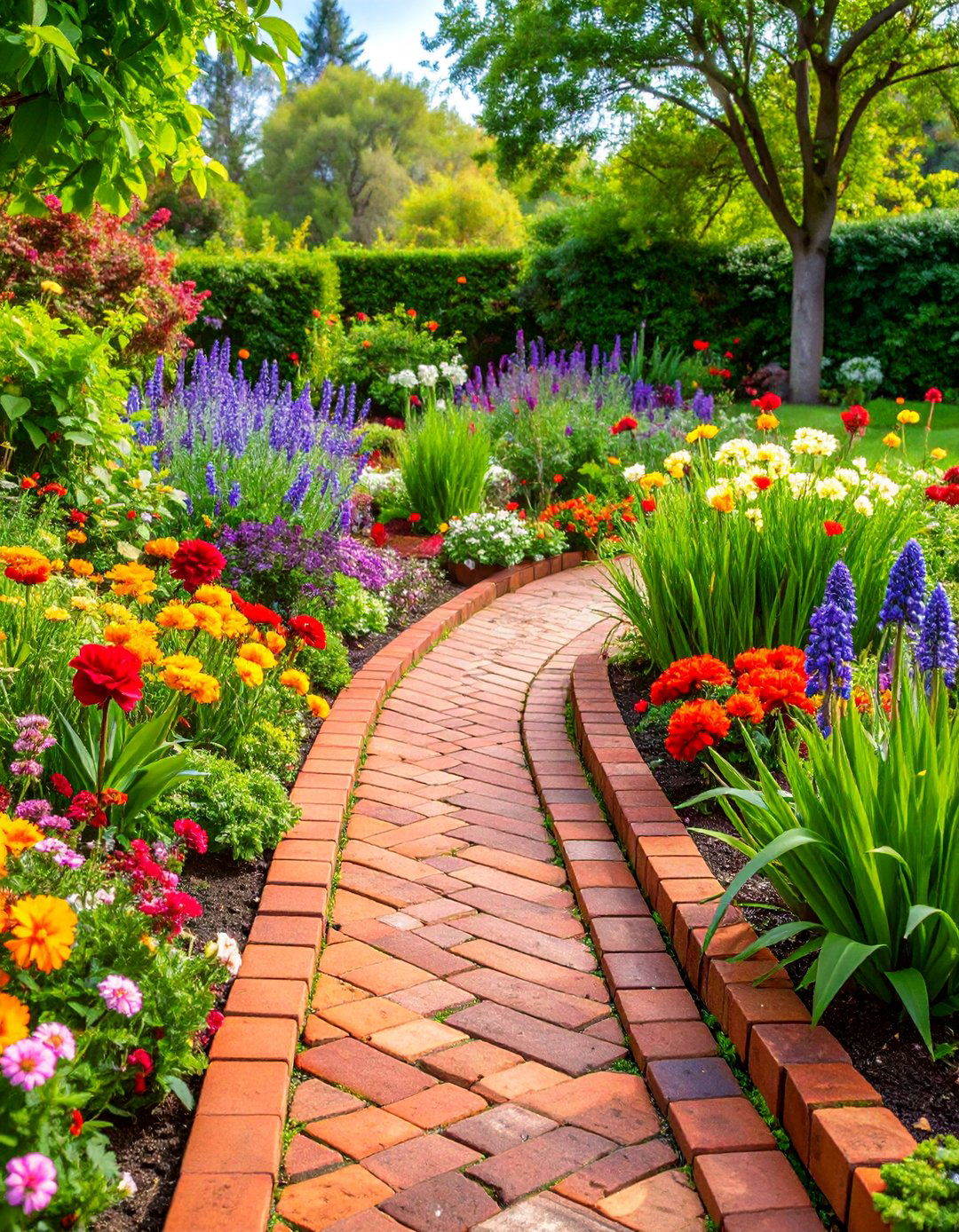

Leave a Reply